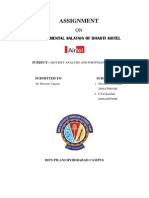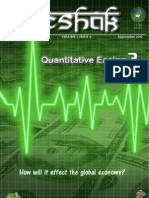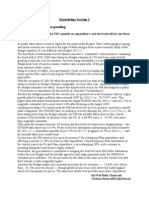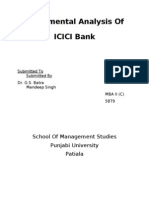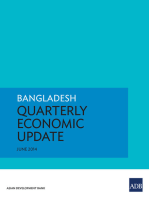Abhyaas Business Bulletin - January 16th, 2012
Abhyaas Business Bulletin - January 16th, 2012
Uploaded by
Abhyaas Edu CorpCopyright:
Available Formats
Abhyaas Business Bulletin - January 16th, 2012
Abhyaas Business Bulletin - January 16th, 2012
Uploaded by
Abhyaas Edu CorpCopyright
Available Formats
Share this document
Did you find this document useful?
Is this content inappropriate?
Copyright:
Available Formats
Abhyaas Business Bulletin - January 16th, 2012
Abhyaas Business Bulletin - January 16th, 2012
Uploaded by
Abhyaas Edu CorpCopyright:
Available Formats
15th Jan 2012 Edition
ABB20120102
The Abhyaas Business Bulletin for the MBA aspirant in you.
Effective fiscal management need of the hour says FM of India
With the fiscal deficit on the rise owing to a decrease in revenue and growth expenditure, Finance Minister, Mr. Pranab Mukherjee stated that prudent fiscal management was the need of the hour. Saying that the deficit should not be allowed to go beyond a manageable limit, he added that managing receipts and payments was the key to keeping sovereign borrowings and debts under control. He also said that there were lessons to be learnt from the current Eurozone crisis where sovereign fiscal deficits of some nations had surpassed 100% of GDP, and warned that such breach of fiscal deficit targets would have their implications. Fiscal deficit is essentially the difference between what the government spends and what it earns and is expressed as a percentage of GDP. When a government fails to match its expenses against its earnings, it tries to bridge the gap by borrowing and has to resort to deficit financing. The budgeted fiscal deficit target for the current financial year was estimated to be 4.6% of the GDP, however, since the governments extra borrowing on account of rising subsidy bills, and resources from disinvestment not coming through, the target is very much under pressure. The government is not likely to meet its disinvestment target of Rs. 40,000 crore and has already announced borrowing an additional Rs. 90,000 crore to bridge the revenue-expenditure gap. On the other hand, the subsidy bill during the current financial year is expected to increase by an additional Rs. one lakh crore. Mr. Mukherjee also discussed the need to provide better taxpayer services, making collection systems more rule-based and transparent as better services would result in more compliance and said that all efforts were being made to improve collection of taxes. Emphasizing that timely refund would increase the confidence among tax payers, he stated that refunds of Rs. 73,000 crore were already made so far this year. Which are the countries with debt to GDP ratio more than 100%? What are PIIG countries? Why are some countries able to hold up their economy with high levels of debt while others are not? Identify other ways to raise money for government apart from disinvestment, borrowings and tax collections.
www.abhyaas.in
From the Editors desk:
Hello Reader, Welcome to the Abhyaas Business Bulletin for the New Year! I hope this year brings you a lot more success, happiness, satisfaction and good luck. In this edition, we will cover the significant business happenings in India and the world in the first fortnight of 2012. The New Year brought some cheer to the common man as food inflation rates touching new lows and prices of vegetables reducing significantly. Also, the FDI in retail for single-brands and the Auto Expo held in the capital made headlines in the nation. Internationally, the mass downgrade of European countries by credit rating agency, Standard and Poors renewed fears of an impending global financial crisis, though the scenario in the U.S looking much brighter. Do read the entire bulletin thoroughly to get a heads-up into the business events occurring around the world. Try and figure out answers for the questions provided at the end of each of the news bits to better your knowledge of current affairs. The intent of the bulletin, apart from just providing you with the snippets of news is also for you to read more, and know in detail about them. All the answers to the questions would be discussed in the Abhyaas GD-PI programme which has already begun.
Index: Page 2: Stock Market and Indicators Page 3: National Business News Page 4: International Business News
(Ms. Sonal Jaiswal)
The Abhyaas Business Bulletin
15th Jan 2012 Edition
ABB20120102
Stock Markets across the World (1st January 15th January, 2012) )
Macro Indicators
Bank Rate Repo Rate Reverse Repo Rate SLR CRR Exchange Rate(with USD) Inflation(WPI) % Change 6.00% 8.50% 7.50% 24.00% 6.00% 51.43 -2.90%
Other Indicators
Crude Oil(NYMEX) Crude Oil(BRENT) Gold Price(Indian Bullion) 98.7 $/barrel 110.4 $/barrel 2739.33 INR/gm
(As on 15th Jan, 2012)
Overview
Indian stock markets started the New Year on a positive note. Sensex and Nifty advanced by 4.53% and 5.23% in the last fortnight after having dropped around 25% in the year 2011. Nikkei index barely advanced with a 0.53% increase over the fortnight but Chinas Shanghai Index performed better by advancing over 2.05% in the same period. London's FTSE 100 moved up by around 1.17% while NASDAQ has been one of the biggest gainers, registered a positive movement of 4.13% this fortnight. While stronger economic news is emanating from US in the last quarter, re-emerging concerns about Europe's debt crisis pushed the Euro to a 16-month low against the dollar.
www.abhyaas.in The Abhyaas Business Bulletin 2
15th Jan 2012 Edition
ABB20120102
100% FDI in single-brand retail notified
The government, on 10th January eliminated restrictions on Foreign Direct Investment (FDI) in the retail sector for single brand owners and notified 100% investment, increasing the cap from a previous 51%. However, foreign retailers looking at 100% ownership must necessarily source at least 30% of their goods from domestic small industries, village or cottage industries that have invested a maximum of 5 crore in their plants. This would pave the way for global fashion brands like Adidas, Armani, Gucci etc. to intensify their consumer base in India, which are currently running with Indian partners. Commerce and Industry Minister, Anand Sharma said that this initiative would provide the necessary stimulus and technical upgradation to the domestic manufacturing sector. Shortly after this was announced, shares of Indian retailers like Pantaloons and Shoppers Stop rose significantly. Why has this notification resulted in a positive market reaction? Which industry sectors would be benefited from this? How does 100% ownership help a foreign retailer in a new territory like India?
Is negative inflation a good sign for economy? Think of any other indicators where base effect would have significant impact. What is headline inflation? Is it different from WPI? Which organization determines the WPI?
Moody's upgrades India's currency rating to investment grade
U.S based credit rating agency, Moodys upgraded the country's rating of short-term foreign currency bank deposits from speculative' to investment' grade on 10th January. The Finance Ministry announced that the elevation in grade was made from NP (Not Prime) to P-3 (suggesting acceptable ability to repay short-term obligations). Domestic companies will now have an advantage in raising funds from overseas markets at better rates and consequently, the money flow in the nation is to improve. In less than a month, this is the fourth upgrade by Moodys, boosting the chances of Indian banks in raising overseas deposits at finer rates. In the past month, it upgraded short-term government bonds denominated in domestic currency from NP to P-3; increased long-term government bond denominated in domestic currency from Ba1' to Baa3' an enhancement from speculative to investment grade. Also, the long-term country ceiling on foreign currency bank deposit was upgraded from Ba1 to Baa3.
What are the different speculative and investment grades used by S&P and Moody's? How are speculative grades different from junk grades? How would this upgrade help the economy of India?
Food inflation turns negative; RBI may reduce rates
The year-end brought cheer to the junta and the policy makers as food inflation entered the negative sphere dwindling to -3.36% during the week ending December 24th, maintaining the year-end low inflation rates. Also, during the week that ended the year 2011, it still remained negative at -2.9%. The lowest rates in around 6 years are attributed in part to the decrease in the prices of edibles and in part to the base effect. Base effect, in economic parlance, is the rate of inflation in the corresponding year-ago period, which was 21% in the week ending 24th December and 19.1% in 31st December-ending week in 2010 respectively. The sharp decline according to the Wholesale Price Index (WPI) data prompted C. Rangarajan, Chairman of the Prime Ministers Economic Advisory Council to state that the RBI would reverse its monetary policy in its next review to be held on the 24th of January and would look at a countermand to accentuate the industrial growth. Also, Finance Minister, Pranab Mukherjee said that if the same rates persisted, then the headline inflation at the end of the fiscal year would be manageable.
www.abhyaas.in
11th Auto Expo held in Delhi; Indian auto sector is 7th largest
The 11th Auto expo kicked off in the capital at Pragati Maidan from 7 11 January, 2012. It saw a horde of car manufacturers unveiling their automobiles with Maruti Suzuki, the countrys biggest car manufacturer unveiling its compact sport-utility vehichle (SUV) XA Alpha and compact multi-purpose vehicle (MPV) Ertiga. Indian design studio, DC Design also revealed Avanti the first sports-car from India while Ford showed off a swank design concept of the EcoSport, and called it the urban SUV. Amid this, the Society of Indian Automobile Manufacturers (SIAM), forecasted an increase of 11-13% in the car sales for the fiscal year 2013. Which are the six large auto markets other than India? What are the other sectors in which India holds better rank in terms of market size? What is an SUV? What are the different classes of Cars and how are they classified?
3
The Abhyaas Business Bulletin
15th Jan 2012 Edition
ABB20120102
S & P downgrades France, Austria, 7 other Eurozone nations
Reigniting fears over Europe not being able to bail itself out of the financial crisis, U.S based credit rating agency, Standard & Poors downgraded by one notch the triple A rating of France and Austria, and seven other nations that include Italy and Spain on a dark Friday, the 13th. Germany, Eurozones biggest economy though, retained its AAA rating along with Netherlands, Finland and Luxembourg while Portugals debt was relegated to junk. Malta, Slovakia and Slovenia were downgraded by one notch, while Italy, Spain, Portugal and Cyprus were demoted by two notches. S & P said that the EU summit last month did not yield sufficient results of to overcome a crisis. This also comes in the wake of talks between Greek negotiators and holders of its debt breaking down over how large bondholders losses should be on 13th. If no agreement is reached, Greece will need billions of euros to aid it in making a bond repayment in March. While the mass downgrade provoked immense backlash from the political community in Europe, Frances Finance Minister, Franois Baroin tried to downplay it saying that policies of France would not be dictated by rating agencies. Also, the Chinese news agency, Xinhua said that the Global credit rating agencies have a responsibility to not amplify the current financial debt crisis. Why are few Euro countries downgraded while others are not? How does a rating agency work and gain credibility? Do you agree with Xinhua's view that rating agencies shouldn't amplify the crisis in the European economy?
Systems (US), Atmos Energy (US).
How are 'Growth Outliers' identified? Would you invest in Infosys/HDFC based on this input? What does EVA mean and who introduced it? How is it calculated? Is it similar to 'Growth Outliers' concept?
US consumer sentiment strongest since May, 2011
According to Thomson Reuters and University of Michigan index released on the 13th of January, Americans grew more optimistic about job prospects early in the year as consumer sentiment rose to the highest levels in eight months. Consumer sentiment recorded 74 which was the highest since May, 2011 after it touched 69.9 in December, 2011. More frequent mentions of rising employment and lessened income uncertainty prompted favourable buying attitudes as well, thus increasing the overall satisfaction, said Richard Curtin, Director of the survey. Should this survey be taken seriously? Are there any such surveys conducted in India and who conducts them? What are the different types of sampling used in such surveys and which is the best method?
B School Spotlight: S. P. Jain Institute of Management
S. P. Jain institute of Management & Research (SPJIMR) is an autonomous management institute in Delhi with entrepreneurial agility, personal freedom with professional accountability and corporatized culture, structure and processes. It is rated as one of the best B-schools in India and South Asia. The flagship course of SPJIMR is the Post Graduate Diploma in Management (PGDM) which is a two-year, full time, residential programme. Having 180 seats and currently running in its 27th year, it offers specializations in finance, operations, marketing and information management and boasts of a successful and well-known alumnus. Apart from PGDM, SPJIMR offers many other programmes like Post Graduate Programme in Management (PGPM), which is an eleven month, full-time, residential programme; Post Graduate Executive Management Programme spread over 4 phases over a 21-month duration etc. For more details log onto http://www.spjimr.org
Infosys, HDFC in Harvard Business Review's top 10 growth list
Bangalore-based IT services organization Infosys, and Mumbai-based banking and financial services company HDFC Bank were among the elite group of 10 companies around the globe, identified by Harvard Business Review as those ones that have consistently fared better than others around the world over a ten-year period between 1999 and 2009, growing their net incomes by 5% every year, beating volatility. 'Growth Outliers' was the name given to the elite list of 10 companies that had a market capitalization of at least $1 billion. The other companies included Yahoo Japan, ACS (Spain), Cognizant (US), Tsingtao Brewery (China), Indra Sistemas (Spain), Krka Group (Slovenia), Factsheet Research
www.abhyaas.in
For further info contact us at: info@abhyaas.in
4
The Abhyaas Business Bulletin
You might also like
- Audit Test 120514Document3 pagesAudit Test 120514DanCoppe14% (7)
- Case Study ENT600 THDocument21 pagesCase Study ENT600 THRap Duta33% (3)
- Auditing TheoryDocument27 pagesAuditing Theorysharielles /No ratings yet
- KasdanPiutang 4B Kelompok1Document11 pagesKasdanPiutang 4B Kelompok1Estin TasyaNo ratings yet
- Fundamental Analysis of Airtel ReportDocument29 pagesFundamental Analysis of Airtel ReportKoushik G SaiNo ratings yet
- Helping You Spot Opportunities: Investment Update - October, 2012Document56 pagesHelping You Spot Opportunities: Investment Update - October, 2012Carla TateNo ratings yet
- Helping You Spot Opportunities: Investment Update - August, 2013Document55 pagesHelping You Spot Opportunities: Investment Update - August, 2013akcool91No ratings yet
- Niveshak Niveshak: India Vision 2020Document24 pagesNiveshak Niveshak: India Vision 2020Niveshak - The InvestorNo ratings yet
- HDFC Securities Annual Report 11-12 FinalDocument35 pagesHDFC Securities Annual Report 11-12 Finaljohn_muellorNo ratings yet
- Indian EconomyDocument13 pagesIndian EconomyPraval SaiNo ratings yet
- Niveshak Niveshak: AuditorsDocument26 pagesNiveshak Niveshak: AuditorsNiveshak - The InvestorNo ratings yet
- 2.1. Economic Analysis:: Boom Recovery Recession Depression Invest DisinvestDocument5 pages2.1. Economic Analysis:: Boom Recovery Recession Depression Invest DisinvestbatkiNo ratings yet
- World Economic Forum: Niveshak NiveshakDocument28 pagesWorld Economic Forum: Niveshak NiveshakNiveshak - The InvestorNo ratings yet
- OwowDocument46 pagesOwowprasadsangamNo ratings yet
- Fundamental Analysis of Hero HondaDocument20 pagesFundamental Analysis of Hero Hondasanjayrammfc100% (2)
- Niveshak Niveshak: Financial Woes of India'S Rising SunDocument24 pagesNiveshak Niveshak: Financial Woes of India'S Rising SunNiveshak - The InvestorNo ratings yet
- IndiaEconomicGrowth SDocument16 pagesIndiaEconomicGrowth SAmol SaxenaNo ratings yet
- Project KMFDocument96 pagesProject KMFLabeem SamanthNo ratings yet
- Opinion Columns C.R.L. Narasimhan: Worrying Numbers Compound ProblemsDocument2 pagesOpinion Columns C.R.L. Narasimhan: Worrying Numbers Compound ProblemsSourabh SharmaNo ratings yet
- Why You Should Track Macro DataDocument3 pagesWhy You Should Track Macro DataTarun KumarNo ratings yet
- Equity Research: (Series IV) 10th August 2012Document18 pagesEquity Research: (Series IV) 10th August 2012kgsbppNo ratings yet
- Niveshak Sept 2012Document24 pagesNiveshak Sept 2012Niveshak - The InvestorNo ratings yet
- SPEX Issue 22Document10 pagesSPEX Issue 22SMU Political-Economics Exchange (SPEX)No ratings yet
- Finance Questions and AnswersDocument35 pagesFinance Questions and AnswersRohitNo ratings yet
- Knowledge Session 1Document8 pagesKnowledge Session 1Rishi ChourasiaNo ratings yet
- Fiscal Deficit InfoDocument12 pagesFiscal Deficit InfoSanket AiyaNo ratings yet
- ECONOMIC ANALYSIS DaburDocument5 pagesECONOMIC ANALYSIS DaburEKANSH DANGAYACH 20212619No ratings yet
- Hallenges For The Indian Economy in 2017Document7 pagesHallenges For The Indian Economy in 2017Asrar SheikhNo ratings yet
- Economics Contemporary Questions and AnswersDocument12 pagesEconomics Contemporary Questions and AnswersSameer ShaikhNo ratings yet
- Recent Development in Global Financial MarketDocument8 pagesRecent Development in Global Financial MarketBini MathewNo ratings yet
- Masala 2011Document9 pagesMasala 2011gauhar77No ratings yet
- Finsight 18march2012Document11 pagesFinsight 18march2012Rahul UnnikrishnanNo ratings yet
- Analysis of Indian EconomyDocument41 pagesAnalysis of Indian EconomySaurav GhoshNo ratings yet
- Answer All Questions. 2. All Sub-Parts of A Question Must Be Answered Together Else They Would Not Be EvaluatedDocument4 pagesAnswer All Questions. 2. All Sub-Parts of A Question Must Be Answered Together Else They Would Not Be EvaluatedBIBIN VARGHESENo ratings yet
- Eic AnalysisDocument17 pagesEic AnalysisJaydeep Bairagi100% (1)
- Etm 2011 8 22 33Document1 pageEtm 2011 8 22 33Saurabh DardaNo ratings yet
- Fundamental Analysis of Axis and ICICI BankDocument18 pagesFundamental Analysis of Axis and ICICI BankAnu100% (2)
- Bank of BarodaDocument61 pagesBank of BarodaAnita VarmaNo ratings yet
- JSTREET Volume 322Document10 pagesJSTREET Volume 322JhaveritradeNo ratings yet
- Foreign Direct Investment and Its Impact: Vivekanandha College of Arts and Sciences For Womens ElayampalayamDocument8 pagesForeign Direct Investment and Its Impact: Vivekanandha College of Arts and Sciences For Womens Elayampalayamanon_209785390No ratings yet
- Crisil Yearbook On The Indian Debt Market 2015.unlockedDocument114 pagesCrisil Yearbook On The Indian Debt Market 2015.unlockedPRATIK JAINNo ratings yet
- Indian Economy - Nov 2019Document6 pagesIndian Economy - Nov 2019Rajeshree JadhavNo ratings yet
- Economic Reforms: Kirit Jain Roll No:14Document9 pagesEconomic Reforms: Kirit Jain Roll No:14kirit19900% (1)
- Economics IA MACRODocument7 pagesEconomics IA MACROAayush KapriNo ratings yet
- Indian EconomyDocument38 pagesIndian EconomyIQAC VMDCNo ratings yet
- Empower June 2012Document68 pagesEmpower June 2012pravin963No ratings yet
- The Indian Kaleidoscope: Emerging Trends in RetailDocument52 pagesThe Indian Kaleidoscope: Emerging Trends in RetailSwati Agarwal100% (1)
- Overheating: Niranjan Rajadhyaksha's Previous ColumnsDocument5 pagesOverheating: Niranjan Rajadhyaksha's Previous ColumnsVaibhav KarthikNo ratings yet
- Mar 282012 GseDocument4 pagesMar 282012 GseAhmed NirobNo ratings yet
- India Opens Stock Market To Foreign InvestorsDocument4 pagesIndia Opens Stock Market To Foreign InvestorsSharad SrivastavaNo ratings yet
- Concept Note:: Resentation TranscriptDocument4 pagesConcept Note:: Resentation TranscriptR.S.TiwariNo ratings yet
- Macro Economics SnapshotDocument12 pagesMacro Economics SnapshotmanjeetsrccNo ratings yet
- Indian Economic Survey 2012Document10 pagesIndian Economic Survey 2012Krunal KeniaNo ratings yet
- Slowdown of Global Economy Opportunity For India & ChinaDocument13 pagesSlowdown of Global Economy Opportunity For India & ChinaMitul Kirtania50% (2)
- Edutap Mock - IFSCA Phase 2Document52 pagesEdutap Mock - IFSCA Phase 2prashantdash5834No ratings yet
- Macro Economic Concepts NewDocument10 pagesMacro Economic Concepts Newshreyas babariaNo ratings yet
- Fundamental Analysis of Icici Bank: School of Management Studies Punjabi University PatialaDocument21 pagesFundamental Analysis of Icici Bank: School of Management Studies Punjabi University Patialapuneet_kissNo ratings yet
- Road Map For NBFC To Banking: A Finance Case StudyDocument13 pagesRoad Map For NBFC To Banking: A Finance Case StudySohini BanerjeeNo ratings yet
- Updates On Issues: Services PmiDocument7 pagesUpdates On Issues: Services PmiAman GoelNo ratings yet
- Strategic Analysis of SBIMFDocument19 pagesStrategic Analysis of SBIMF26amitNo ratings yet
- Macroeconomic Indicators of FMCGDocument13 pagesMacroeconomic Indicators of FMCGArpita PatnaikNo ratings yet
- Abhyaas SET 2017 AnalysisDocument2 pagesAbhyaas SET 2017 AnalysisAbhyaas Edu CorpNo ratings yet
- Abhyaas News Board : For The Quintessential Test Prep StudentDocument8 pagesAbhyaas News Board : For The Quintessential Test Prep StudentAbhyaas Edu CorpNo ratings yet
- Abhyaas News Board : For The Quintessential Test Prep StudentDocument8 pagesAbhyaas News Board : For The Quintessential Test Prep StudentAbhyaas Edu CorpNo ratings yet
- Abhyaas News Board : For The Quintessential Test Prep StudentDocument8 pagesAbhyaas News Board : For The Quintessential Test Prep StudentAbhyaas Edu CorpNo ratings yet
- Abhyaas Law Bulletin February 2016Document4 pagesAbhyaas Law Bulletin February 2016Abhyaas Edu CorpNo ratings yet
- Abhyaas Law Bulletin February 2016Document4 pagesAbhyaas Law Bulletin February 2016Abhyaas Edu CorpNo ratings yet
- SET 2016 AnalysisDocument2 pagesSET 2016 AnalysisAbhyaas Edu CorpNo ratings yet
- Abhyaas Law Bulletin July 2016Document4 pagesAbhyaas Law Bulletin July 2016Abhyaas Edu CorpNo ratings yet
- August Law BulletinDocument4 pagesAugust Law BulletinAbhyaas Edu CorpNo ratings yet
- June Law BulletinDocument4 pagesJune Law BulletinAbhyaas Edu CorpNo ratings yet
- SET 2016 AnalysisDocument2 pagesSET 2016 AnalysisAbhyaas Edu CorpNo ratings yet
- Abhyaas Law Bulletin : For The Quintessential CLAT AspirantDocument4 pagesAbhyaas Law Bulletin : For The Quintessential CLAT AspirantAbhyaas Edu CorpNo ratings yet
- April 2015 Law BulletinDocument4 pagesApril 2015 Law BulletinAbhyaas Edu CorpNo ratings yet
- March Law BulletinDocument4 pagesMarch Law BulletinAbhyaas Edu CorpNo ratings yet
- June Law BulletinDocument4 pagesJune Law BulletinAbhyaas Edu CorpNo ratings yet
- Abhyaas Law Bulletin : For The Quintessential CLAT AspirantDocument4 pagesAbhyaas Law Bulletin : For The Quintessential CLAT AspirantAbhyaas Edu CorpNo ratings yet
- February Law BulletinDocument4 pagesFebruary Law BulletinAbhyaas Edu CorpNo ratings yet
- January Law BulletinDocument4 pagesJanuary Law BulletinAbhyaas Edu CorpNo ratings yet
- October Law BulletinDocument4 pagesOctober Law BulletinAbhyaas Edu CorpNo ratings yet
- September Law BulletinDocument4 pagesSeptember Law BulletinAbhyaas Edu CorpNo ratings yet
- CLAT 2014 AnalysisDocument2 pagesCLAT 2014 AnalysisAbhyaas Edu CorpNo ratings yet
- November Law BulletinDocument4 pagesNovember Law BulletinAbhyaas Edu CorpNo ratings yet
- Abhyaas Law Bulletin - June 2014Document4 pagesAbhyaas Law Bulletin - June 2014Abhyaas Edu CorpNo ratings yet
- Abhyaas Law Bulletin - April 2014Document4 pagesAbhyaas Law Bulletin - April 2014Abhyaas Edu CorpNo ratings yet
- Abhyaas Law Bulletin - AugustDocument4 pagesAbhyaas Law Bulletin - AugustAbhyaas Edu CorpNo ratings yet
- Modules1 20 MergedDocument84 pagesModules1 20 MergedClaw MarksNo ratings yet
- The Financial SystemDocument82 pagesThe Financial SystemGaurav007100% (1)
- 4 Main Features of Schumpeter's Theory of Economic DevelopmentDocument5 pages4 Main Features of Schumpeter's Theory of Economic DevelopmentSennheiserNo ratings yet
- Sec Contact Center: Offices/ Matters of Concern Email AddressDocument1 pageSec Contact Center: Offices/ Matters of Concern Email AddressVinz BiuagNo ratings yet
- Regulatory Framework For Business Transactions Page 1 of 16Document16 pagesRegulatory Framework For Business Transactions Page 1 of 16Christopher Michael OnaNo ratings yet
- Standard Treasury Series A Pitch DeckDocument47 pagesStandard Treasury Series A Pitch DeckRazin MustafizNo ratings yet
- Indian Partnership Act 1932Document10 pagesIndian Partnership Act 1932niginkabrahamNo ratings yet
- InvoiceDocument1 pageInvoiceas6sareenNo ratings yet
- Banking SamplesDocument9 pagesBanking SamplesAmol KaleNo ratings yet
- Purchase Invoice: Pt. Cipta Graha SejahteraDocument4 pagesPurchase Invoice: Pt. Cipta Graha Sejahterayasmina khoirun nisaNo ratings yet
- RR On Estate Tax Amnesty - FINALDocument98 pagesRR On Estate Tax Amnesty - FINALtina0% (1)
- A. 1C Problem 11Document2 pagesA. 1C Problem 11shuzoNo ratings yet
- Case Studies On Financial Instruments and Assets NewDocument3 pagesCase Studies On Financial Instruments and Assets NewOlufemi MoyegunNo ratings yet
- Bank of America: Jump To Navigation Jump To SearchDocument4 pagesBank of America: Jump To Navigation Jump To SearchSakshi BakliwalNo ratings yet
- HDFC MF SIP Performance As On 30th Sep 2024Document2 pagesHDFC MF SIP Performance As On 30th Sep 2024Pazhamalairajan KaliyaperumalNo ratings yet
- Responsibility Accounting Responsibility Accounting - A System of Accounting Wherein Costs and RevenuesDocument3 pagesResponsibility Accounting Responsibility Accounting - A System of Accounting Wherein Costs and RevenuesAriel DicoreñaNo ratings yet
- 年度報告Document4 pages年度報告ewb4kw40100% (1)
- Principles of Project FinanceDocument10 pagesPrinciples of Project FinanceEdgar Diaz NietoNo ratings yet
- Option Pricing Theory and Applications: Aswath DamodaranDocument89 pagesOption Pricing Theory and Applications: Aswath DamodaranJairam PerumalNo ratings yet
- Micro Finance and NGO'sDocument50 pagesMicro Finance and NGO'sMunish Dogra100% (1)
- Sbi Sip Project - Ayush Sinha FinalDocument84 pagesSbi Sip Project - Ayush Sinha FinalFardeen KhanNo ratings yet
- Direct Debit FormDocument1 pageDirect Debit Formkayleighjude95No ratings yet
- Cta Eb CV 01322 D 2016oct17 AssDocument25 pagesCta Eb CV 01322 D 2016oct17 AssMarcy BaklushNo ratings yet
- API Order Types - IG Labs PDFDocument1 pageAPI Order Types - IG Labs PDFLuca PilottiNo ratings yet
- Walking Plutocratic LondonDocument13 pagesWalking Plutocratic London6021000125No ratings yet
- PT Multi Prima Sejahtera TBK 30 Juni 2019Document87 pagesPT Multi Prima Sejahtera TBK 30 Juni 201989junaidiNo ratings yet




